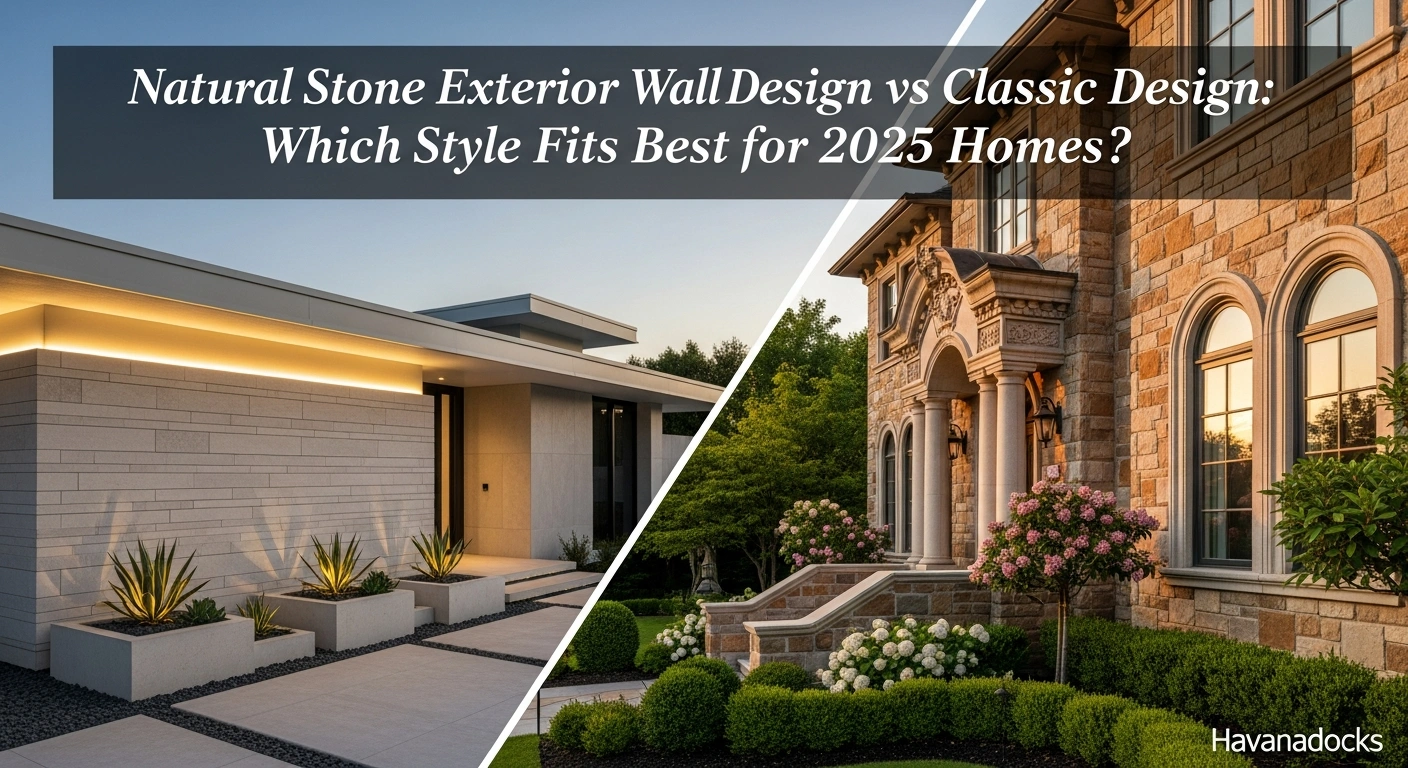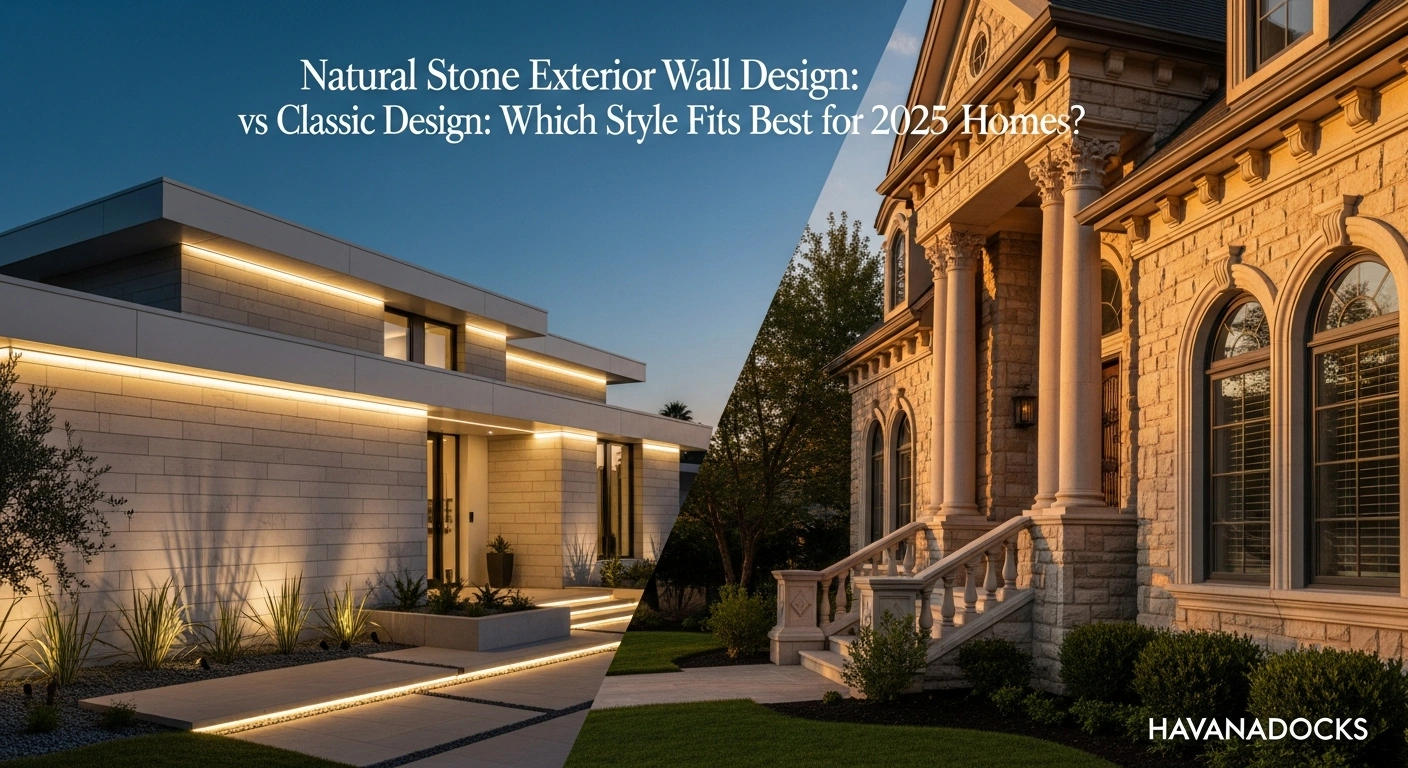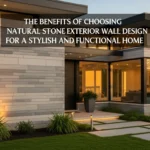Natural Stone Exterior Wall Design vs Classic Design: Which Style Fits Best for 2025 Homes?
Natural Stone Exterior Wall Design vs Classic Design: Which Style Fits Best for 2025 Homes? – The facade of your home is its first impression, a visual handshake with the world that speaks volumes about your taste, values, and vision. As we stand on the cusp of 2025, homeowners and architects are faced with a pivotal choice that will define the character of their properties for decades to come. This decision often crystallizes into a compelling debate: the organic, timeless appeal of a natural stone exterior versus the familiar, structured comfort of classic design.
This is more than a simple aesthetic preference; it’s a declaration of intent. Do you lean towards the enduring legacy of the earth itself, or the established traditions of architectural history? The discussion of Natural Stone Exterior Wall Design vs Classic Home Design is about choosing a narrative for your home, one that will weather trends, seasons, and time itself.

The Enduring Allure of Classic Home Design
Classic home design stands as one of the most enduring expressions of human creativity — an architectural language that transcends fashion, technology, and time. It is the foundation of residential beauty, the reference point from which all other styles have evolved. Rooted in symmetry, proportion, and an unwavering respect for craftsmanship, classic design represents more than a collection of aesthetic choices — it is a philosophy of living grounded in permanence, comfort, and grace.
At its core, classic design is a dialogue between tradition and timelessness. It looks backward with reverence but never feels outdated. Whether it’s the crisp geometry of Colonial architecture, the intricate ornamentation of Victorian homes, or the handcrafted intimacy of the Craftsman era, every classic form is united by a commitment to harmony. The façade of a classic home tells a story of balance — windows align with doors, gables crown entrances, and every molding or column exists with clear purpose. This symmetry is not merely decorative; it speaks to a deeper human desire for order, structure, and beauty that feels both familiar and reassuring.
The materials that define this style are equally steeped in meaning. Brick, stone, stucco, and wood are timeless elements that connect the home to the natural world. Their textures and tones convey authenticity and warmth. Unlike synthetic finishes that may fade or date over time, these materials age with dignity, developing a soft patina that enhances their charm. A classic brick wall or a cedar-shingled roof does not lose its character — it deepens with every passing season, becoming a living testament to endurance and care.
Inside, classic design continues its narrative of elegance and craftsmanship. Coffered ceilings, detailed cornices, paneled wainscoting, and arched doorways create an interior that feels layered with history. Every detail, no matter how small, is an expression of artistry. Rooms are often defined by clear purpose — a formal dining room for gathering, a stately library for reflection, a grand staircase for a moment of architectural drama. In an age when open plans dominate, this compartmentalized layout offers a sense of intimacy and rhythm that many homeowners find deeply comforting.
Yet the power of classic design is not in nostalgia alone. Its adaptability is one of its greatest strengths. Contemporary interpretations of classic homes seamlessly integrate modern comforts — smart home systems, energy-efficient windows, and sustainable materials — without compromising authenticity. A well-designed classic home in 2025 might feature a geothermal heating system beneath its herringbone floors or LED lighting discreetly illuminating its crown moldings. The structure remains rooted in history, even as its function embraces the future.
Emotionally, the appeal of classic design lies in the sense of belonging and stability it evokes. These homes often remind us of childhood memories, family gatherings, or architectural icons that have stood for generations. There is something profoundly human about stepping into a space that feels as though it has always existed — solid, dignified, and eternal. For homeowners seeking refuge from the transient, fast-paced digital world, the classic home becomes a sanctuary — a place where time slows and where beauty is measured not in trends, but in trust.
From an architectural standpoint, the proportions of classic design follow enduring mathematical and artistic principles. Columns echo the orders of Greek and Roman antiquity; façades are arranged along golden ratios that subconsciously please the eye. Even when reinterpreted through modern materials or layouts, these timeless principles remain. That is why a Georgian townhouse, a Tudor revival, or a neoclassical villa can sit harmoniously beside a contemporary structure — its beauty is universal, not bound by era.
In a world increasingly driven by impermanence and reinvention, classic home design offers something rare — continuity. It is architecture that whispers rather than shouts, that prefers quiet confidence to novelty. Its beauty does not depend on bold colors or experimental shapes but on the enduring interplay of light, shadow, texture, and form. To choose a classic home is to choose a legacy — a commitment to quality, heritage, and a sense of place that will never go out of style.
Ultimately, the enduring allure of classic home design lies in its ability to remind us who we are. It anchors us in a lineage of builders, craftsmen, and dreamers who understood that a home is not simply a structure, but a reflection of life itself. In every arch, every molding, and every carefully aligned façade, there is a quiet promise: that true beauty does not chase the moment — it endures across generations.

The Ascent of Natural Stone: A Bold Statement for the Future
Now, a powerful shift is reshaping the architectural landscape. Natural stone exteriors are no longer reserved for rustic lodges or historic manors; they are the premier choice for contemporary, forward-thinking homes. This represents a move towards authenticity, strength, and a deeper connection with the natural world.
A home clad in natural stone is a testament to permanence and unparalleled luxury. Each slab of granite, limestone, or slate tells a geological story millions of years in the making. The essential question of Natural Stone Exterior Wall Design vs Classic Home Design becomes a choice between manufactured uniformity and bespoke, natural artistry.
Unpacking the Aesthetics: Organic Beauty vs. Structured Elegance
The visual difference between these two approaches is profound. Classic designs offer a refined and predictable beauty, with uniform colors and textures that create a harmonious, controlled appearance. This structured elegance is calming and orderly, appealing to a sense of tradition.
Conversely, a natural stone exterior is a canvas of organic artistry. The unique veining, diverse color palettes, and rich textures create a dynamic facade that changes with the light throughout the day. This is a bold, one-of-a-kind statement that manufactured materials simply cannot replicate.
Durability and Longevity: A Battle Across Millennia
When it comes to resilience, the debate of Natural Stone Exterior Wall Design vs Classic Home Design finds a clear frontrunner. Classic materials, while reliable, have inherent vulnerabilities. Wood can be susceptible to rot and pests, stucco can crack, and vinyl siding can fade or warp over time.
Natural stone, forged by immense pressure and heat, is a champion of durability. It is inherently resistant to fire, pests, and the harshest weather conditions, from scorching sun to freezing winters. Choosing a natural stone exterior is an investment in a structure that will stand strong for generations, not just years.
Versatility in the Modern Age: Beyond the Rustic Cliche
A common misconception is that natural stone is limited to traditional or rustic aesthetics. The reality is that its versatility is one of its greatest strengths in modern architecture. Sleek, polished limestone panels can create an ultra-modern, minimalist facade.
Rough, split-face travertine can add a touch of mediterranean warmth to a contemporary home. The ability to cut, finish, and combine different types of stone allows for infinite creative expression. This adaptability solidifies its place as a superior choice for the diverse architectural visions of 2025.
The 2025 Homeowner: A Profile of Modern Values
To truly understand the ongoing debate between Natural Stone Exterior Wall Design vs Classic Home Design, we must first understand the evolving mindset of the modern homeowner. The 2025 homeowner is not merely a consumer of architecture but an active participant in shaping how their living environment reflects their identity, beliefs, and aspirations. Their decisions are guided not by fleeting trends or glossy catalog images but by deeper values — authenticity, sustainability, individuality, and long-term worth.
The modern home is no longer just a shelter or a status symbol. It has become a personal manifesto, an architectural expression of who its owner is and what they stand for. The era of mass production and disposable design is fading. In its place emerges a generation that values craftsmanship, traceability, and emotional resonance. They want homes that tell stories — structures that age gracefully, reflect integrity in material choice, and stand as testaments to mindful living.
This shift represents a quiet revolution in residential design philosophy. The homeowners of 2025 are deeply aware of their environmental footprint. They prioritize natural materials, energy efficiency, and the sourcing of building products that honor both the planet and the people involved in their creation. But beyond this eco-consciousness lies something more profound — a desire for connection. Connection to nature, to place, and to the tactile beauty of real materials that ground them in an increasingly digital world.
The Craving for Authenticity and Uniqueness
In a society saturated with replicas, filters, and virtual experiences, authenticity has become the ultimate form of luxury. The digital age has made visual perfection commonplace — but emotional depth and uniqueness remain rare. Homeowners are responding by turning toward materials and designs that cannot be duplicated or mass-produced.
Classic home design, with its well-ordered symmetry and traditional palette, continues to hold undeniable appeal. Its sense of history and familiarity provides comfort and continuity. However, the materials often used in classic exteriors — uniform brick, smooth stucco, or painted wood — speak of craftsmanship, yes, but also of repetition. Each brick is nearly identical to the next, forming a collective beauty that relies on precision rather than individuality.
Natural stone, by contrast, tells a very different story. No two stones are ever alike. Each carries the marks of geological time — subtle veining, color variations, mineral inclusions, and textures shaped by nature itself. When used on a home’s exterior, this uniqueness translates into a façade that is utterly one-of-a-kind. It’s not assembled from standardized components; it’s composed from pieces of the earth, each with its own history and character. For the modern homeowner, this individuality resonates on a deeply personal level. Their home becomes a true reflection of themselves — distinctive, timeless, and impossible to replicate.
Sustainability Meets Legacy
The 2025 homeowner also thinks in terms of legacy rather than lifespan. They invest in materials that endure — not just physically, but ethically. Natural stone, with its longevity and minimal processing, offers a sustainable alternative to synthetic facades or heavily manufactured products. Its durability reduces replacement cycles, while its natural origin ensures that even after decades of use, it remains environmentally sound.
Classic designs can be adapted for sustainability, but the modern preference for raw, honest materials aligns perfectly with natural stone’s inherent virtues. Homeowners increasingly seek transparency in sourcing — knowing where their materials come from, how they are extracted, and what impact they have on the environment. In this sense, stone embodies the values of authenticity and stewardship that define modern luxury.
This alignment of sustainability and artistry marks a new era of homeownership. The beauty of a natural stone exterior is not only visual but ethical. It represents a conscious decision to build with integrity — to choose materials that will outlast fleeting trends, stand strong against time, and minimize harm to the environment. For many, that ethical satisfaction is as important as aesthetic appeal.

Sustainability and Eco-Conscious Living
Environmental consciousness is a defining feature of the modern era. The discussion of Natural Stone Exterior Wall Design vs Classic Home Design must therefore include an analysis of ecological impact. Many classic cladding options involve energy-intensive manufacturing processes and chemicals.
Natural stone is a quintessentially “green” building material. It is a natural, non-toxic product of the earth, requiring less energy to process than many manufactured alternatives. Its incredible longevity also means less waste from replacement and repairs over the building’s lifespan.
The Low-Maintenance Advantage
A significant, practical benefit of natural stone is its minimal need for upkeep. Unlike wood siding that requires regular staining and sealing or painted surfaces that need refreshing, natural stone maintains its beauty for decades with little more than occasional cleaning. This translates to saved time, money, and effort over the life of the home.
In the argument of Natural Stone Exterior Wall Design vs Classic Home Design, this low-maintenance aspect is a powerful persuader. It allows homeowners to enjoy their home’s beauty without the burden of constant and costly maintenance. This is a feature that directly enhances quality of life.
Enhancing Property Value: A Tangible Return on Investment
A home is often the most significant financial investment a person will make. A natural stone exterior is not an expense; it is a direct investment in the property’s long-term value. Its timeless appeal and superior durability are highly sought-after features in the real estate market.
Homes with natural stone exteriors consistently command higher resale values and spend less time on the market. In the financial side of the Natural Stone Exterior Wall Design vs Classic Home Design equation, stone provides a tangible, impressive return. It is a choice that pays dividends for years to come.
Making the Right Choice for Your 2025 Home
Choosing your home’s exterior is a deeply personal decision that should align with your aesthetic, lifestyle, and budget. While a classic design offers a safe and familiar path, the evidence points compellingly towards natural stone as the superior choice for the future. It meets the modern demand for beauty, performance, and conscious living.
Consider your long-term vision. Are you building a home for a decade, or for a lifetime? The initial investment in a natural stone exterior is offset by its incredible lifespan, low maintenance costs, and increased property value.
When you weigh all the factors in the Natural Stone Exterior Wall Design vs Classic Home Design comparison, stone emerges as the intelligent, forward-thinking option. It is a choice that looks to the future without forgetting the timeless power of the past. It offers a connection to the natural world that is both grounding and inspiring.
Conclusion: Your Future, Carved in Stone
As we look to 2025, the homes we build must be more than just structures; they must be sanctuaries of authenticity, strength, and sustainable beauty. While classic design will always have its place, it represents a conversation with the past. A natural stone exterior is a conversation with eternity.
The debate of Natural Stone Exterior Wall Design vs Classic Home Design is ultimately resolved by the values of the modern era. The choice for a natural stone facade is a commitment to unparalleled uniqueness, unwavering durability, and a deep, tangible connection to the earth. For the 2025 home, it is not just the best choice; it is the definitive statement of a lasting legacy.






